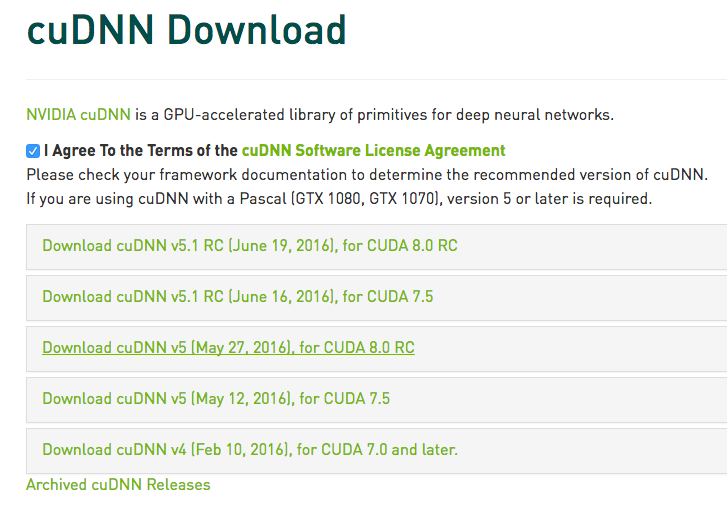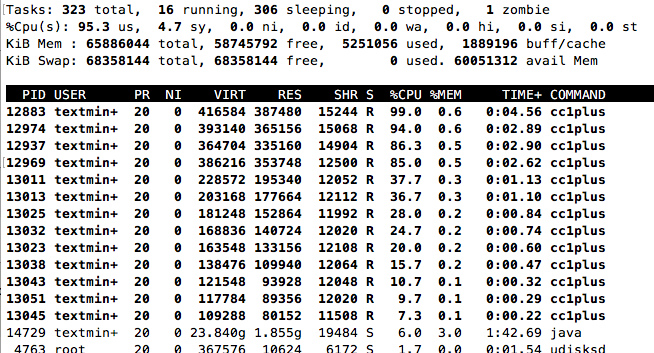
Update: 文章写于一年前,有些地方已经不适合了,最近升级了一下深度学习服务器,同时配置了一下环境,新写了文章,可以同时参考: 从零开始搭建深度学习服务器: 基础环境配置(Ubuntu + GTX 1080 TI + CUDA + cuDNN) 从零开始搭建深度学习服务器: 深度学习工具安装(TensorFlow + PyTorch + Torch)
这个系列写了好几篇文章,这是相关文章的索引,仅供参考:
- 深度学习主机攒机小记
- 深度学习主机环境配置: Ubuntu16.04+Nvidia GTX 1080+CUDA8.0
- 深度学习主机环境配置: Ubuntu16.04+GeForce GTX 1080+TensorFlow
- 深度学习服务器环境配置: Ubuntu17.04+Nvidia GTX 1080+CUDA 9.0+cuDNN 7.0+TensorFlow 1.3
- 从零开始搭建深度学习服务器:硬件选择
- 从零开始搭建深度学习服务器: 基础环境配置(Ubuntu + GTX 1080 TI + CUDA + cuDNN)
- 从零开始搭建深度学习服务器: 深度学习工具安装(TensorFlow + PyTorch + Torch)
- 从零开始搭建深度学习服务器: 深度学习工具安装(Theano + MXNet)
- 从零开始搭建深度学习服务器: 1080TI四卡并行(Ubuntu16.04+CUDA9.2+cuDNN7.1+TensorFlow+Keras)
接上文《深度学习主机环境配置: Ubuntu16.04+Nvidia GTX 1080+CUDA8.0》,我们继续来安装 TensorFlow,使其支持GeForce GTX 1080显卡。
1 下载和安装cuDNN
cuDNN全称 CUDA Deep Neural Network library,是NVIDIA专门针对深度神经网络设计的一套GPU计算加速库,被广泛用于各种深度学习框架,例如Caffe, TensorFlow, Theano, Torch, CNTK等。
The NVIDIA CUDA® Deep Neural Network library (cuDNN) is a GPU-accelerated library of primitives for deep neural networks. cuDNN provides highly tuned implementations for standard routines such as forward and backward convolution, pooling, normalization, and activation layers. cuDNN is part of the NVIDIA Deep Learning SDK.
Deep learning researchers and framework developers worldwide rely on cuDNN for high-performance GPU acceleration. It allows them to focus on training neural networks and developing software applications rather than spending time on low-level GPU performance tuning. cuDNN accelerates widely used deep learning frameworks, including Caffe, TensorFlow, Theano, Torch, and CNTK. See supported frameworks for more details.
首先需要下载cuDNN,直接从Nvidia官方下载链接选择一个版本,不过下载cuDNN前同样需要登录甚至填写一个简单的调查问卷: https://developer.nvidia.com/rdp/cudnn-download,这里选择的是支持CUDA8.0的cuDNN v5版本,而支持CUDA8的5.1版本虽然显示在下载选择项里,但是提示:cuDNN 5.1 RC for CUDA 8RC will be available soon - please check back again.

安装cuDNN比较简单,解压后把相应的文件拷贝到对应的CUDA目录下即可:
tar -zxvf cudnn-8.0-linux-x64-v5.0-ga.tgz
cuda/include/cudnn.h
cuda/lib64/libcudnn.so
cuda/lib64/libcudnn.so.5
cuda/lib64/libcudnn.so.5.0.5
cuda/lib64/libcudnn_static.a
sudo cp cuda/include/cudnn.h /usr/local/cuda/include/
sudo cp cuda/lib64/libcudnn* /usr/local/cuda/lib64/
sudo chmod a+r /usr/local/cuda/include/cudnn.h
sudo chmod a+r /usr/local/cuda/lib64/libcudnn*
2 通过源代码方式编译安装TensorFlow GPU版本
TensorFlow的CPU版本安装比较简单,在Ubuntu 环境下通过PIP方式安装即可,具体请参考TensorFlow官方安装文档。这里通过源代码编译安装TensorFlow 0.9版本,使其支持相应的GPU:GTX1080。
1) Python相关环境准备
这里使用的是Python2.7版本,在Ubuntu16.04下安装相关依赖:
sudo apt-get install python-pip
sudo apt-get install python-numpy swig python-dev python-wheel
2)安装Google构建工具Bazel
Bazel是Google官方开源的一个构建工具,用来配合Google的软件开发模式,有以下几个特点:
多语言支持:Bazel支持Java,Objective-C和C++,可以扩展来支持任意的编程语言
高级别的构建语言:工程是通过BUILD语言来描述的。BUILD语言以简洁的文本格式,描述了由多个小的互相关联的库、二进制程序和测试程序来组成的一个项目。而与之相比,Make这类的工具需要描述各个单独的文件和编译的命令
多平台支持:同一套工具和同样的BUILD文件可以用来构建不同架构和不同平台的软件。在Google,我们使用Bazel来构建在我们数据中心系统中运行的服务器端程序和在手机上运行的客户端应用程序。
重现性[Reproducibility]:在BUILD文件中,每个库,测试程序,二进制文件必须明确完整地指定直接依赖。当修改源代码文件后,Bazel使用这个依赖信息就可以知道哪些必须重新构建,哪些任务可以并行执行。这意味者所有的构建都是增量形式的并能够每次都生成相同的结果。
伸缩性[Scalability]:Bazel可以处理巨大的构建;在Google,一个服务器端程序超过100k的源码是常有的事情,如果没有文件被改动,构建过程需要大约200ms
从Bazel github上最新的Linux relase版本:
wget https://github.com/bazelbuild/bazel/releases/download/0.3.0/bazel-0.3.0-installer-linux-x86_64.sh
下载完毕后执行:
chmod +x bazel-0.3.0-installer-linux-x86_64.sh
./bazel-0.3.0-installer-linux-x86_64.sh --user
提示错误:
Java not found, please install the corresponding package
See http://bazel.io/docs/install.html for more information on
应该是没有安装Java环境的问题,bazel需要Java JDK 8,在ubuntu16.04直接apt-get安装即可:
sudo apt-get update
sudo apt-get install default-jre
sudo apt-get install default-jdk
安装完毕后,再次执行Bazel安装脚本:
./bazel-0.3.0-installer-linux-x86_64.sh --user
Bazel installer
---------------# Release 0.3.0 (2016-06-10)
Baseline: a9301fa
Cherry picks:
+ ff30a73: Turn --legacy_external_runfiles back on by default
+ aeee3b8: Fix delete[] warning on fsevents.ccIncompatible changes:
- The --cwarn command line option is not supported anymore. Use
--copt instead.New features:
- On OSX, --watchfs now uses FsEvents to be notified of changes
from the filesystem (previously, this flag had no effect on OS X).
- add support for the '-=', '*=', '/=', and'%=' operators to
skylark. Notably, we do not support '|=' because the semantics
of skylark sets are sufficiently different from python sets.Important changes:
- Use singular form when appropriate in blaze's test result summary
message.
- Added supported for Android NDK revision 11
- --objc_generate_debug_symbols is now deprecated.
- swift_library now generates an Objective-C header for its @objc
interfaces.
- new_objc_provider can now set the USES_SWIFT flag.
- objc_framework now supports dynamic frameworks.
- Symlinks in zip files are now unzipped correctly by http_archive,
download_and_extract, etc.
- swift_library is now able to import framework rules such as
objc_framework.
- Adds "jre_deps" attribute to j2objc_library.
- Release apple_binary rule, for creating multi-architecture
("fat") objc/cc binaries and libraries, targeting ios platforms.
- Aspects documentation added.
- The --ues_isystem_for_includes command line option is not
supported anymore.
- global function 'provider' is removed from .bzl files. Providers
can only be accessed through fields in a 'target' object.## Build informations
- [Build log](http://ci.bazel.io/job/Bazel/JAVA_VERSION=1.8,PLATFORM_NAME=linux-x86_64/595/)
- [Commit](https://github.com/bazelbuild/bazel/commit/e671d29)
Uncompressing......Extracting Bazel installation...
.Bazel is now installed!
Make sure you have "/home/textminer/bin" in your path. You can also activate bash
completion by adding the following line to your ~/.bashrc:
source /home/textminer/.bazel/bin/bazel-complete.bashSee http://bazel.io/docs/getting-started.html to start a new project!
然后在 ~/.bashrc中追加:
source /home/textminer/.bazel/bin/bazel-complete.bash
export PATH=$PATH:/home/textminer/.bazel/bin
追加的第一行的原因在这里:
Bazel comes with a bash completion script. To install it:
Build it with Bazel: bazel build //scripts:bazel-complete.bash.
Copy the script bazel-bin/scripts/bazel-complete.bash to your completion folder (/etc/bash_completion.d directory under Ubuntu). If you don't have a completion folder, you can copy it wherever suits you and simply insert source /path/to/bazel-complete.bash in your ~/.bashrc file (under OS X, put it in your ~/.bash_profile file).
最后执行
source ~/.bashrc
至此,Bazel安装完毕。
3) 编译安装TensorFlow:
首先从github上克隆TensorFlow最新的代码:
git clone https://github.com/tensorflow/tensorflow
代码下载完毕之后,进入tensorflow主目录,执行:
./configure
会有一系列提示:
Please specify the location of python. [Default is /usr/bin/python]:
Do you wish to build TensorFlow with Google Cloud Platform support? [y/N] y
Google Cloud Platform support will be enabled for TensorFlow
ERROR: It appears that the development version of libcurl is not available. Please install the libcurl3-dev package.
第二项"是否选择Google云平台的支持"选择y之后出现了一个错误,需要libcurl,用apt-get安装,当然,基于国内的网络现状,这一项也可以选择no:
sudo apt-get install libcurl3 libcurl3-dev
安装完毕之后重新执行
./configure
除了两处选择yes or no 的地方外,其他地方一路回车:
Please specify the location of python. [Default is /usr/bin/python]:
Do you wish to build TensorFlow with Google Cloud Platform support? [y/N] y
Google Cloud Platform support will be enabled for TensorFlow
Do you wish to build TensorFlow with GPU support? [y/N] y
GPU support will be enabled for TensorFlow
Please specify which gcc nvcc should use as the host compiler. [Default is /usr/bin/gcc]:
Please specify the Cuda SDK version you want to use, e.g. 7.0. [Leave empty to use system default]:
Please specify the location where CUDA toolkit is installed. Refer to README.md for more details. [Default is /usr/local/cuda]:
Please specify the Cudnn version you want to use. [Leave empty to use system default]:
Please specify the location where cuDNN library is installed. Refer to README.md for more details. [Default is /usr/local/cuda]:
Please specify a list of comma-separated Cuda compute capabilities you want to build with.
You can find the compute capability of your device at: https://developer.nvidia.com/cuda-gpus.
Please note that each additional compute capability significantly increases your build time and binary size.
[Default is: "3.5,5.2"]:
Setting up Cuda include
Setting up Cuda lib64
Setting up Cuda bin
Setting up Cuda nvvm
Setting up CUPTI include
Setting up CUPTI lib64
Configuration finished
最后就是通过Bazel进行编译安装了:
bazel build -c opt --config=cuda //tensorflow/cc:tutorials_example_trainer
这个过程中需要通过git下载和编译google protobuf 和 boringssl:
INFO: Cloning https://github.com/google/protobuf: Receiving objects
INFO: Cloning https://github.com/google/boringssl.git: Receiving objects
....
不过第一次安装的时候遇到报错:
configure: error: zlib not installed
Target //tensorflow/cc:tutorials_example_trainer failed to build
google了一下,需要安装zlib1g-dev:
sudo apt-get install zlib1g-dev
之后重新编译安装TensorFlow就没有问题了,不过需要等待一段时间:

编译TensorFlow成功结束的时候,提示如下:
......
Target //tensorflow/cc:tutorials_example_trainer up-to-date:
bazel-bin/tensorflow/cc/tutorials_example_trainer
INFO: Elapsed time: 897.845s, Critical Path: 533.72s
执行一下TensorFlow官方文档里的例子,看看能否成功调用GTX 1080:
bazel-bin/tensorflow/cc/tutorials_example_trainer --use_gpu
I tensorflow/stream_executor/dso_loader.cc:108] successfully opened CUDA library libcublas.so locally
I tensorflow/stream_executor/dso_loader.cc:108] successfully opened CUDA library libcudnn.so locally
I tensorflow/stream_executor/dso_loader.cc:108] successfully opened CUDA library libcufft.so locally
I tensorflow/stream_executor/dso_loader.cc:108] successfully opened CUDA library libcuda.so.1 locally
I tensorflow/stream_executor/dso_loader.cc:108] successfully opened CUDA library libcurand.so locally
I tensorflow/core/common_runtime/gpu/gpu_init.cc:102] Found device 0 with properties:
name: GeForce GTX 1080
major: 6 minor: 1 memoryClockRate (GHz) 1.835
pciBusID 0000:01:00.0
Total memory: 7.92GiB
Free memory: 7.65GiB
I tensorflow/core/common_runtime/gpu/gpu_init.cc:126] DMA: 0
I tensorflow/core/common_runtime/gpu/gpu_init.cc:136] 0: Y
I tensorflow/core/common_runtime/gpu/gpu_device.cc:838] Creating TensorFlow device (/gpu:0) -> (device: 0, name: GeForce GTX 1080, pci bus id: 0000:01:00.0)
I tensorflow/core/common_runtime/gpu/gpu_device.cc:838] Creating TensorFlow device (/gpu:0) -> (device: 0, name: GeForce GTX 1080, pci bus id: 0000:01:00.0)
I tensorflow/core/common_runtime/gpu/gpu_device.cc:838] Creating TensorFlow device (/gpu:0) -> (device: 0, name: GeForce GTX 1080, pci bus id: 0000:01:00.0)
I tensorflow/core/common_runtime/gpu/gpu_device.cc:838] Creating TensorFlow device (/gpu:0) -> (device: 0, name: GeForce GTX 1080, pci bus id: 0000:01:00.0)
I tensorflow/core/common_runtime/gpu/gpu_device.cc:838] Creating TensorFlow device (/gpu:0) -> (device: 0, name: GeForce GTX 1080, pci bus id: 0000:01:00.0)
I tensorflow/core/common_runtime/gpu/gpu_device.cc:838] Creating TensorFlow device (/gpu:0) -> (device: 0, name: GeForce GTX 1080, pci bus id: 0000:01:00.0)
I tensorflow/core/common_runtime/gpu/gpu_device.cc:838] Creating TensorFlow device (/gpu:0) -> (device: 0, name: GeForce GTX 1080, pci bus id: 0000:01:00.0)
I tensorflow/core/common_runtime/gpu/gpu_device.cc:838] Creating TensorFlow device (/gpu:0) -> (device: 0, name: GeForce GTX 1080, pci bus id: 0000:01:00.0)
I tensorflow/core/common_runtime/gpu/gpu_device.cc:838] Creating TensorFlow device (/gpu:0) -> (device: 0, name: GeForce GTX 1080, pci bus id: 0000:01:00.0)
I tensorflow/core/common_runtime/gpu/gpu_device.cc:838] Creating TensorFlow device (/gpu:0) -> (device: 0, name: GeForce GTX 1080, pci bus id: 0000:01:00.0)
000003/000006 lambda = 1.841570 x = [0.669396 0.742906] y = [3.493999 -0.669396]
000006/000007 lambda = 1.841570 x = [0.669396 0.742906] y = [3.493999 -0.669396]
000009/000006 lambda = 1.841570 x = [0.669396 0.742906] y = [3.493999 -0.669396]
000009/000004 lambda = 1.841570 x = [0.669396 0.742906] y = [3.493999 -0.669396]
000000/000005 lambda = 1.841570 x = [0.669396 0.742906] y = [3.493999 -0.669396]
000000/000004 lambda = 1.841570 x = [0.669396 0.742906] y = [3.493999 -0.669396]
......
没有问题,说明这种通过源代码编译TensorFlow使其支持GPU的方式已经成功了。再在Python中调用一下TensorFlow:
import tensorflow as tf
提示错误:
ImportError: cannot import name pywrap_tensorflow
虽然我们通过源代码安装编译的TensorFlow可用,但是Python版本并没有ready,所以继续:
bazel build -c opt --config=cuda //tensorflow/tools/pip_package:build_pip_package
bazel-bin/tensorflow/tools/pip_package/build_pip_package /tmp/tensorflow_pkg
sudo pip install /tmp/tensorflow_pkg/tensorflow-0.9.0-py2-none-any.whl
Requirement already satisfied (use --upgrade to upgrade): setuptools in /usr/lib/python2.7/dist-packages (from protobuf==3.0.0b2->tensorflow==0.9.0)
Installing collected packages: six, funcsigs, pbr, mock, protobuf, tensorflow
Successfully installed funcsigs-1.0.2 mock-2.0.0 pbr-1.10.0 protobuf-3.0.0b2 six-1.10.0 tensorflow-0.9.0
我们再次打开ipython,试一下tensorflow官方样例:
Python 2.7.12 (default, Jul 1 2016, 15:12:24)
Type "copyright", "credits" or "license" for more information.
IPython 2.4.1 -- An enhanced Interactive Python.
? -> Introduction and overview of IPython's features.
%quickref -> Quick reference.
help -> Python's own help system.
object? -> Details about 'object', use 'object??' for extra details.
In [1]: import tensorflow as tf
I tensorflow/stream_executor/dso_loader.cc:108] successfully opened CUDA library libcublas.so locally
I tensorflow/stream_executor/dso_loader.cc:108] successfully opened CUDA library libcudnn.so locally
I tensorflow/stream_executor/dso_loader.cc:108] successfully opened CUDA library libcufft.so locally
I tensorflow/stream_executor/dso_loader.cc:108] successfully opened CUDA library libcuda.so.1 locally
I tensorflow/stream_executor/dso_loader.cc:108] successfully opened CUDA library libcurand.so locally
In [2]: import numpy as np
In [3]: x_data = np.random.rand(100).astype(np.float32)
In [4]: y_data = x_data * 0.1 + 0.3
In [5]: W = tf.Variable(tf.random_uniform([1], -1.0, 1.0))
In [6]: b = tf.Variable(tf.zeros([1]))
In [7]: y = W * x_data + b
In [8]: loss = tf.reduce_mean(tf.square(y - y_data))
In [9]: optimizer = tf.train.GradientDescentOptimizer(0.5)
In [10]: train = optimizer.minimize(loss)
In [11]: init = tf.initialize_all_variables()
In [12]: sess = tf.Session()
I tensorflow/core/common_runtime/gpu/gpu_init.cc:102] Found device 0 with properties:
name: GeForce GTX 1080
major: 6 minor: 1 memoryClockRate (GHz) 1.835
pciBusID 0000:01:00.0
Total memory: 7.92GiB
Free memory: 7.65GiB
I tensorflow/core/common_runtime/gpu/gpu_init.cc:126] DMA: 0
I tensorflow/core/common_runtime/gpu/gpu_init.cc:136] 0: Y
I tensorflow/core/common_runtime/gpu/gpu_device.cc:838] Creating TensorFlow device (/gpu:0) -> (device: 0, name: GeForce GTX 1080, pci bus id: 0000:01:00.0)
In [13]: sess.run(init)
In [14]: for step in range(201):
....: sess.run(train)
....: if step % 20 == 0:
....: print(step, sess.run(W), sess.run(b))
....:
(0, array([-0.10331395], dtype=float32), array([ 0.62236434], dtype=float32))
(20, array([ 0.03067014], dtype=float32), array([ 0.3403711], dtype=float32))
(40, array([ 0.08353967], dtype=float32), array([ 0.30958495], dtype=float32))
(60, array([ 0.09609199], dtype=float32), array([ 0.30227566], dtype=float32))
(80, array([ 0.09907217], dtype=float32), array([ 0.3005403], dtype=float32))
(100, array([ 0.09977971], dtype=float32), array([ 0.30012828], dtype=float32))
(120, array([ 0.0999477], dtype=float32), array([ 0.30003047], dtype=float32))
(140, array([ 0.0999876], dtype=float32), array([ 0.30000722], dtype=float32))
(160, array([ 0.09999706], dtype=float32), array([ 0.30000171], dtype=float32))
(180, array([ 0.09999929], dtype=float32), array([ 0.30000043], dtype=float32))
(200, array([ 0.09999985], dtype=float32), array([ 0.3000001], dtype=float32))
终于OK了,之后就可以尽情享用基于GTX 1080 GPU版的TensorFlow了。
参考:
TensorFlow: Installing from sources
Tensorflow on Ubuntu 16.04 with Nvidia GTX 1080
TensorFlow, Caffe, Chainer と Deep Learning大御所を一気に source code build で GPU向けに setupしてみた
GTX-1080でTensorFlow
Jack47 Bazel解读系列
注:原创文章,转载请注明出处及保留链接“我爱自然语言处理”:https://www.52nlp.cn
本文链接地址:深度学习主机环境配置: Ubuntu16.04+GeForce GTX 1080+TensorFlow https://www.52nlp.cn/?p=9285
我的电脑有两块tesla显卡:
运行时候会出现
Peer access not supported between device ordinals 0 and 1
好像我的显卡之间没有连接,是这样的吗?谢谢
[回复]
52nlp 回复:
27 12 月, 2016 at 11:18
具体不太清楚,你看看这个issue的讨论吧,貌似没有结果:
https://github.com/tensorflow/tensorflow/issues/2145
不过当时提示这个问题目前影响不大,以后说不上来:
“Today, you are not losing much if peer-to-peer access is not enabled. But it might have performance implication for future TensorFlow releases.
If you want to debug this issue locally, you can run the Cuda SDK sample simpleP2P and see if there is a problem.”
[回复]
我想问下我跑了三个不同的tf代码,用的不同的数据集,包括官方给出的mnist,每个进程显存占用都是111MB。
但在跑NVIDIA_CUDA-8.0_Samples时可以占满显存的,这是什么情况?
[回复]
52nlp 回复:
22 2 月, 2017 at 09:20
不清楚,这个和数据量有关吧
[回复]
博主您好,我下载了cudnn后tar -zxvf cudnn-8.0-linux-x64-v5.0-ga.tgz执行没问题,但是下面几条输入后都显示missing destination file operand after '......'
sudo cp cuda/include/cudnn.h /usr/local/cuda/include/
sudo cp cuda/lib64/libcudnn* /usr/local/cuda/lib64/
sudo chmod a+r /usr/local/cuda/include/cudnn.h
sudo chmod a+r /usr/local/cuda/lib64/libcudnn*
是哪里出了问题吗?谢谢您。
[回复]
52nlp 回复:
16 4 月, 2017 at 09:58
一条一条执行呢?貌似你是一次性拷贝进去执行的,这种提示的话貌似是cp没有拷贝目标地址
[回复]
张同宝 回复:
16 4 月, 2017 at 17:47
我是一条一条执行的
[回复]
博主,又来麻烦你了,这次是tensorflow下载的问题。
ztb@112pro:~$ cd tensorflow
ztb@112pro:~/tensorflow$ ./configure
Please specify the location of python. [Default is /usr/bin/python]:
Please specify optimization flags to use during compilation when bazel option "--config=opt" is specified [Default is -march=native]:
Do you wish to use jemalloc as the malloc implementation? [Y/n] y
jemalloc enabled
Do you wish to build TensorFlow with Google Cloud Platform support? [y/N] y
Google Cloud Platform support will be enabled for TensorFlow
Do you wish to build TensorFlow with Hadoop File System support? [y/N] y
Hadoop File System support will be enabled for TensorFlow
Do you wish to build TensorFlow with the XLA just-in-time compiler (experimental)? [y/N] y
XLA JIT support will be enabled for TensorFlow
Found possible Python library paths:
/usr/local/lib/python2.7/dist-packages
/usr/lib/python2.7/dist-packages
Please input the desired Python library path to use. Default is [/usr/local/lib/python2.7/dist-packages]
Using python library path: /usr/local/lib/python2.7/dist-packages
Do you wish to build TensorFlow with OpenCL support? [y/N] y
OpenCL support will be enabled for TensorFlow
Do you wish to build TensorFlow with CUDA support? [y/N] y
CUDA support will be enabled for TensorFlow
Do you want to use clang as CUDA compiler? [y/N] y
Clang will be used as CUDA compiler
Please specify which clang should be used as device and host compiler. [Default is ]:
到这就停了,啥也没了不知道哪里出了问题。能不能帮忙解答一下。
[回复]
52nlp 回复:
17 4 月, 2017 at 09:36
不太清楚,但是你上面选择了太多的YES貌似你的环境不一定支持吧。另外你是在什么环境下做这个编译的?
[回复]
张同宝 回复:
17 4 月, 2017 at 13:53
我用的是Ubuntu16.04系统,驱动是GTX1080,但系统是双系统,会不会有什么影响。
[回复]
52nlp 回复:
17 4 月, 2017 at 15:30
这个问题应该不大,但是tensorflow已经进化到1.0之上了,你这个流程中貌似有些地方不一样,例如这里:
Do you want to use clang as CUDA compiler? [y/N] y
Clang will be used as CUDA compiler
Please specify which clang should be used as device and host compiler. [Default is ]:
你选 N试试。另外上面的一些依赖如果没有必要,也可以选N
需要自己sudo apt install clang 就有default选项了
[回复]
博主,请问如果做文本处理,用到深度学习,不做图像处理,还需要配GTX1080这么好的显卡吗?
[回复]
52nlp 回复:
29 7 月, 2017 at 21:25
不一定1080, 开始阶段1070, 1060也行,量力而行。
[回复]
博主,您好!请问如果只做文本处理,用到深度学习算法,不做图像处理,还需要配置GTX1080这么好的显卡吗?求教了,谢谢博主!
[回复]
52nlp 回复:
29 7 月, 2017 at 21:23
与你的数据规模有关,数据规模大了,还是可以配置一下。
[回复]
目前tensorflow支持CUDA9吗?我是4.9的内核,装不了cuda8,导致有个cuda8下面的.so文件找不到!
楼主有什么好建议吗?
[回复]
52nlp 回复:
14 8 月, 2017 at 09:30
这个不太清楚
[回复]